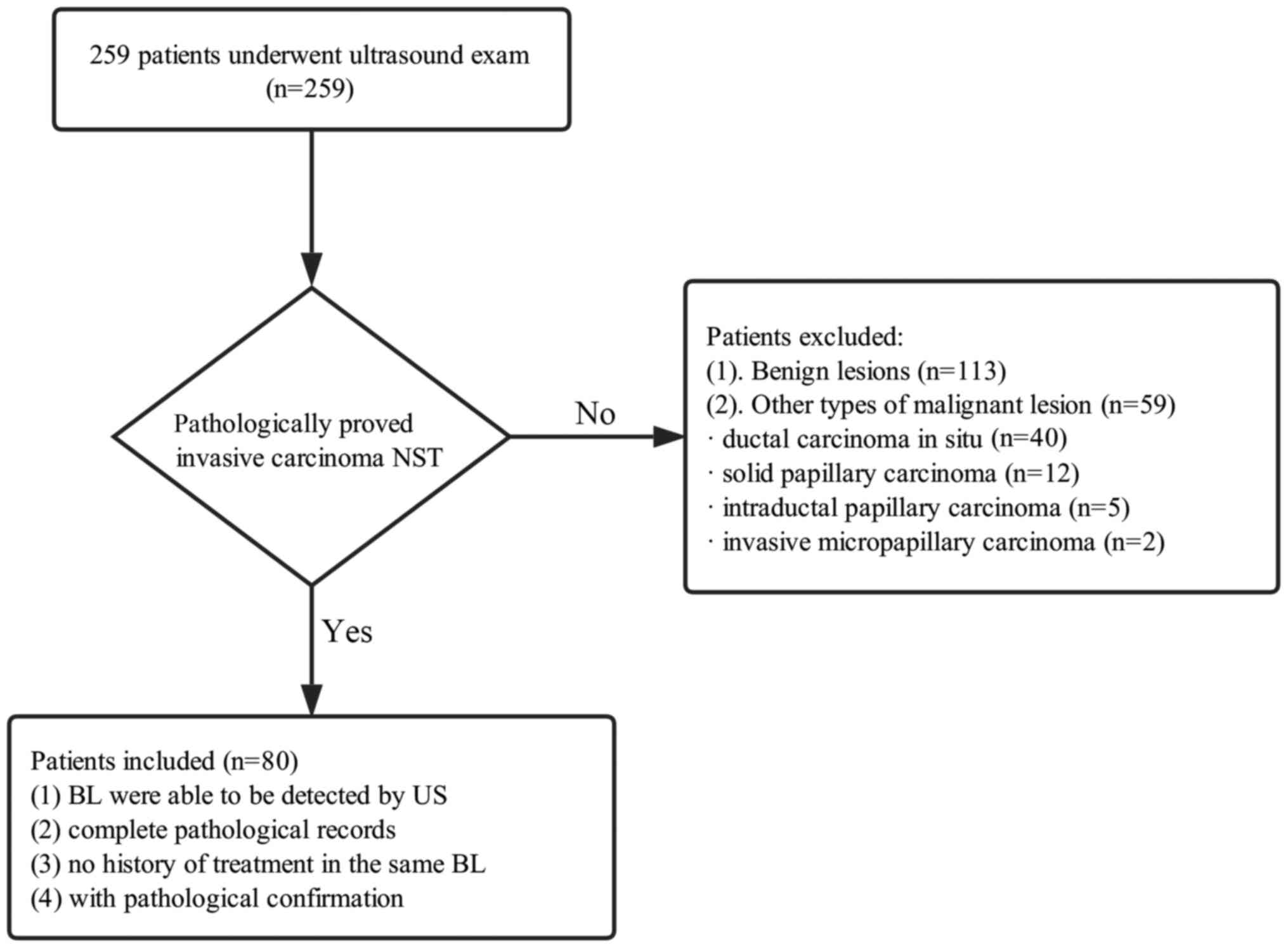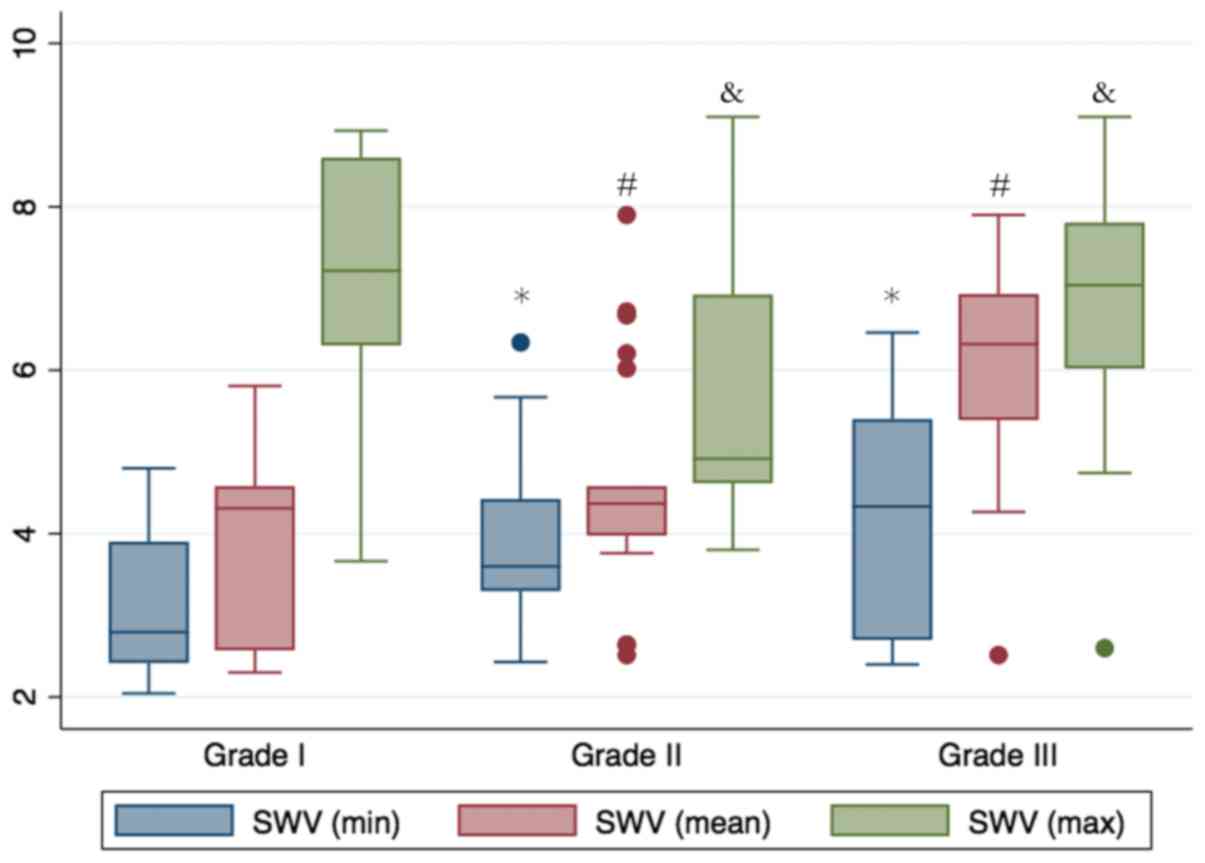|
1
|
Zuo TT, Zheng RS, Zeng HM, Zhang SW and
Chen WQ: Female breast cancer incidence and mortality in China,
2013. Thorac Cancer. 8:214–218. 2017. View Article : Google Scholar : PubMed/NCBI
|
|
2
|
Schatten H: Cell and molecular biology of
breast cancer. Humana Press; 2013, View Article : Google Scholar
|
|
3
|
Reed McCart AE, Kalaw E, Reid A and
Lakhani SR: Breast Cancer—Pathology and GeneticsReference Module in
Biomedical Sciences. Elsevier; 2018, View Article : Google Scholar
|
|
4
|
Luo J, Cao Y, Nian W, Zeng X, Zhang H, Yue
Y and Yu F: Benefit of shear-wave elastography in the differential
diagnosis of breast lesion: A diagnostic meta-analysis. Med
Ultrason. 1:43–49. 2018. View
Article : Google Scholar : PubMed/NCBI
|
|
5
|
Chamming's F, Latorre-Ossa H, Le
Frere-Belda MA, Fitoussi VT, Quibel T, Assayag F, Marangoni E,
Autret G, Balvay D, Pidial L, et al: Shear wave elastography of
tumour growth in a human breast cancer model with pathological
correlation. Eur Radiol. 23:2079–2086. 2013. View Article : Google Scholar : PubMed/NCBI
|
|
6
|
Lakhani SR, Ellis IO, Schnitt SJ, Tan PH
and van de Vijver MJ: WHO Classification of Tumours of the Breast
(4th). 2012.
|
|
7
|
Elston CW and Ellis IO: Pathological
prognostic factors in breast cancer I. The value of histological
grade in breast cancer: Experience from a large study with
long-term follow-up. Histopathology. 41:154–161. 2002.PubMed/NCBI
|
|
8
|
Li T, Mello-Thoms C and Brennan PC:
Descriptive epidemiology of breast cancer in China: Incidence,
mortality, survival and prevalence. Breast Cancer Res Treat.
159:395–406. 2016. View Article : Google Scholar : PubMed/NCBI
|
|
9
|
Chang J, Clark GM, Allred DC, Mohsin S,
Chamness G and Elledge RM: Survival of patients with metastatic
breast carcinoma: Importance of prognostic markers of the primary
tumor. Cancer. 97:545–553. 2003. View Article : Google Scholar : PubMed/NCBI
|
|
10
|
Weidner N, Cady B and Goodson WH III:
Pathologic prognostic factors for patients with breast carcinoma:
Which factors are important. Surg Oncol Clin N Am. 6:415–462. 1997.
View Article : Google Scholar : PubMed/NCBI
|
|
11
|
Irshad A, Ackerman SJ, Pope TL, Moses CK,
Rumboldt T and Panzegrau B: Rare breast lesions: Correlation of
imaging and histologic features with who classification.
Radiographics. 28:1399–1414. 2008. View Article : Google Scholar : PubMed/NCBI
|
|
12
|
Wang WS, Hardesty L, Borgstede J,
Takahashi J and Sams S: Breast cancers found with digital breast
tomosynthesis: A comparison of pathology and histologic grade.
Breast J. 22:651–656. 2016. View Article : Google Scholar : PubMed/NCBI
|
|
13
|
Kim TH, Kang DK, Kim JY, Han S and Jung Y:
Histologic grade and decrease in tumor dimensions affect axillary
lymph node status after neoadjuvant chemotherapy in breast cancer
patients. J Breast Cancer. 18:394–399. 2015. View Article : Google Scholar : PubMed/NCBI
|
|
14
|
Blaichman J, Marcus JC, Alsaadi T,
El-Khoury M, Meterissian S and Mesurolle B: Sonographic appearance
of invasive ductal carcinoma of the breast according to histologic
grade. Am J Roentgenol. 199:402–408. 2012. View Article : Google Scholar
|
|
15
|
Rotstein AH and Neerhut PK: Ultrasound
characteristics of histologically proven grade 3 invasive ductal
breast carcinoma. Australas Radiol. 49:476–479. 2005. View Article : Google Scholar : PubMed/NCBI
|
|
16
|
Gozzi G, Cressa C, Bazzocchi M, Stanta G
and Vidali C: Causes of attenuation of the sound waves in neoplasms
of the breast: Histologic and echographic correlation study (In
Italian). Radiol Med. 72:195–198. 1986.PubMed/NCBI
|
|
17
|
Zhang FJ, Han RL and Zhao XM: The value of
virtual touch tissue image (VTI) and virtual touch tissue
quantification (VTQ) in the differential diagnosis of thyroid
nodules. Eur J Radiol. 83:2033–2040. 2014. View Article : Google Scholar : PubMed/NCBI
|
|
18
|
Zhao Y, Xi J, Zhao B, Xiong W, Jiang D,
Yang L, Cai Z, Liu T, Jiang H, Rong S and Jin X: Preliminary
evaluation of virtual touch tissue imaging quantification for
differential diagnosis of metastatic and nonmetastatic cervical
lymph nodes. J Ultrasound Med. 36:557–563. 2017. View Article : Google Scholar : PubMed/NCBI
|
|
19
|
Onoyama T, Koda M, Fujise Y, Takata T,
Kawata S, Okamoto T, Miyoshi K, Matono T, Sugihara T, Matsumoto K,
et al: Utility of virtual touch quantification in the diagnosis of
pancreatic ductal adenocarcinoma. Clin Imaging. 42:64–67. 2017.
View Article : Google Scholar : PubMed/NCBI
|
|
20
|
Jin ZQ, Li XR, Zhou HL, Chen JX, Huang X,
Dai HX, Li JW, Chen XD and Xu XH: Acoustic radiation force impulse
elastography of breast imaging reporting and data system category 4
breast lesions. Clin Breast Cancer. 12:420–427. 2012. View Article : Google Scholar : PubMed/NCBI
|
|
21
|
Zhou BG, Wang D, Ren WW, Li XL, He YP, Liu
BJ, Wang Q, Chen SG, Alizad A and Xu HX: Value of shear wave
arrival time contour display in shear wave elastography for breast
masses diagnosis. Sci Rep. 7:70362017. View Article : Google Scholar : PubMed/NCBI
|
|
22
|
Tozaki M, Isobe S and Fukuma E:
Preliminary study of ultrasonographic tissue quantification of the
breast using the acoustic radiation force impulse (ARFI)
technology. Eur J Radiol. 80:e182–e187. 2011. View Article : Google Scholar : PubMed/NCBI
|
|
23
|
Golatta M, Schweitzer-Martin M, Harcos A,
Schott S, Gomez C, Stieber A, Rauch G, Domschke C, Rom J, Schütz F,
et al: Evaluation of virtual touch tissue imaging quantification, a
new shear wave velocity imaging method, for breast lesion
assessment by ultrasound. Biomed Res Int. 2014:9602622014.
View Article : Google Scholar : PubMed/NCBI
|
|
24
|
Evans A, Whelehan P, Thomson K, McLean D,
Brauer K, Purdie C, Baker L, Jordan L, Rauchhaus P and Thompson A:
Invasive breast cancer: Relationship between shear-wave
elastographic findings and histologic prognostic factors.
Radiology. 263:673–677. 2012. View Article : Google Scholar : PubMed/NCBI
|
|
25
|
Youk JH, Gweon HM, Son EJ, Kim JA and
Jeong J: Shear-wave elastography of invasive breast cancer:
Correlation between quantitative mean elasticity value and
immunohistochemical profile. Breast Cancer Res Treat. 138:119–126.
2013. View Article : Google Scholar : PubMed/NCBI
|

















